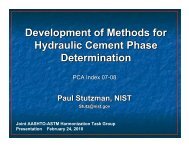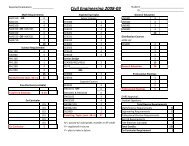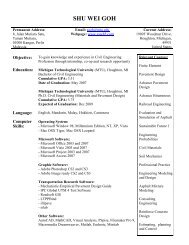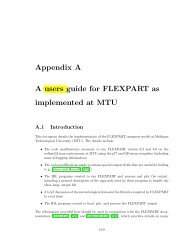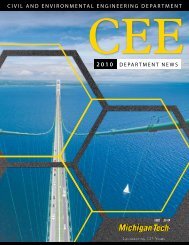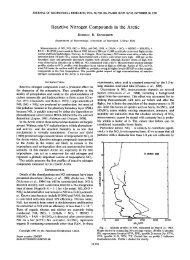Evaluation of Septic Tank and Subsurface Wetland for
Evaluation of Septic Tank and Subsurface Wetland for
Evaluation of Septic Tank and Subsurface Wetland for
You also want an ePaper? Increase the reach of your titles
YUMPU automatically turns print PDFs into web optimized ePapers that Google loves.
solids than a sample point that pulled from the top or mid-stream <strong>of</strong> flow, <strong>and</strong> it would<br />
allow non-buoyant solids to continue to enter the bottle even when full <strong>of</strong> liquid. Another<br />
contributor to high solids may have been the atmospheric exposure <strong>of</strong> the effluent prior to<br />
sample capture. On some occasions there were water bugs or mosquito larvae in the<br />
sample bottle.<br />
Table 5-2 Total Suspended Solids <strong>for</strong> Pisgah <strong>and</strong> Retrieve Sanitation Systems<br />
________________________________________________________________________<br />
Sample Arithmetic Mean 90% Confidence Sample<br />
( X ) mg/l Interval mg/l Size (n)<br />
Pisgah First <strong>Septic</strong> <strong>Tank</strong> 92 X ± 44<br />
5<br />
Pisgah Wetl<strong>and</strong> Influent 57 X ± 57<br />
5<br />
Pisgah Wetl<strong>and</strong> Effluent 13 X ± 9<br />
4<br />
Retrieve First <strong>Septic</strong> <strong>Tank</strong> 41 X ± 21<br />
6<br />
Retrieve Wetl<strong>and</strong> Influent 6 X ± 4<br />
5<br />
Retrieve Wetl<strong>and</strong> Effluent 98 X ± 67<br />
7<br />
An overall TSS reduction <strong>of</strong> 85% was measured in the Pisgah system but an overall<br />
increase in TSS was measured at Retrieve. The Pisgah septic tanks removed an average<br />
<strong>of</strong> 38% <strong>of</strong> their influent <strong>and</strong> the Retrieve septic tank removed 85%. These are near the<br />
removal efficiencies <strong>of</strong> 30 – 81% expected <strong>for</strong> septic tanks (Seabloom et al., 1981;<br />
Rahman et al., 1999). The Pisgah wetl<strong>and</strong> removed 77% <strong>of</strong> influent TSS. This was<br />
within the 63.0 – 89.8% removal efficiency range <strong>for</strong> SSF wetl<strong>and</strong>s reported in literature<br />
(Vymazal, 2000).<br />
Entry zone solids loading rates <strong>for</strong> both wetl<strong>and</strong>s averaged well below the recommended<br />
design limit <strong>of</strong> 0.008 lb/ft2-d (39 g/m2-d) (Crites et al., 1998). The average loading was<br />
0.0013 lb/ft2-d (6.4 g/m2-d) at Pisgah <strong>and</strong> 0.0038 lb/ft2-d (19 g/m2-d) at Retrieve. Entry<br />
zone loading reached an estimated maximum <strong>of</strong> 0.0081 lb/ft2-d (40 g/m2-d) during the<br />
week <strong>of</strong> highest flow rate at Retrieve.<br />
40



